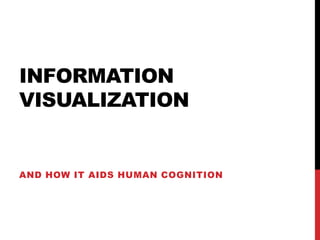How Information Visualization Aids Cognition
- 1. INFORMATION VISUALIZATION AND HOW IT AIDS HUMAN COGNITION
- 2. OUTLINE 1. Motivation 2. What is Information Visualization 3. How it aids human cognition 4. Examples 5. Future work
- 3. INTRODUCTION ? Our society is more complex ? We produce a lot of data ? Data is everywhere ? Internet, computers, sensors ? Photos ? Locations ? News ? Purchases ? Games ? Relationships ? Etc.
- 4. INTRODUCTION ? How do we process all the data so that it is: ? Manageable ? Able to use to monitor changes in data ? Scalable ? Useful ? Easy to understand ? Able to use in data-driven decisions
- 5. HUMAN VISION Quick diversion… The importance of vision: ? Pre-attentive processing ? Parallel processing ? Colour, depth, shape, motion, etc. ? Extends memory and cognitive capacity ? Highest bandwidth sense ? We are visual-thinkers!
- 7. CHALLENGE “Seeing is believing” “A picture is worth a thousand words” We want to take data and allow users to gain insight and form an understanding from it. => Make it useful to people
- 8. INFORMATION? ? Items, entities, things which do not have a direct physical correspondence - John Stasko ?05
- 9. INFO + VISUALIZATION? The use of computer-supported, interactive visual representations of data to amplify cognition - Card, Mackinlay, Shneiderman ?98
- 10. INFORMATION VISUALIZATION ? Not just a process of creating a graphic but a cognitive process ? “The purpose of visualization is insight, not pictures” ? Provide discovery, decision making, explanation, etc.
- 11. INFORMATION VISUALIZATION ? Provide insight into abstract data ? Visuals aid our cognition ? Provide a frame of reference ? Provide temporary memory storage / external cognition ? Visuals can offload work to other processes ? Perceptual system
- 12. INFORMATION VISUALIZATION Information visualization aids cognition in six ways 1. Increases resources 2. Reduces search 3. Supports pattern recognition 4. Allows for perceptual interference 5. Supports perceptual monitoring 6. Supports a manipulable medium
- 13. APPLICATIONS OF INFOVIS ? In-class examples
- 14. FUTURE OF INFORMATION VISUALIZATION ? Fine-tuning evaluation methods ? Scalability ? New methods of interaction ? Creating innovative displays
Editor's Notes
- #4: We come from a generation that generates a lot of data. Data is everywhere, and we are continuing to produce more of it
- #5: people are getting stupidier every day, relatively speakingthe complexity of the world is increasing geometricallybut your ability to learn is the same slow trickle it has always beeninformation is gushing toward your brain like a firehose aimed at a teacup.Comic illustrates the problem at hand. Which is the vast amount of data we have, and the challenge of trying to interpret it efficiently
- #6: In order to answer these questions, we are going to take a quick diversionPreattentive processing : things you can capturewith little effort and no time. This is well studied and useful in advertising, education, and for the prediction of cognitive ability.Visual thinkers = hence this powerpoint presentation as opposed to just speaking to you
- #7: The task is how to take DATA, process it somehow so as to transfer it to KNOWLEDGE.Challenge is to transform the data into information (understanding, insight) thus making it useful to people
- #8: There is a strong relationship between what users see, and how that influences their cognitive process.Infovis = UI for data
- #10: Information visualization is a form of external cognition, using resources in the outside world the mind to amplify what the mind can do
- #11: Understand abstract concepts in more concrete, visual termsCreate familiarity by invoking recognition (see patterns)Infovis aids the user in creating mental models, which allow the user to gather and search through the data fasterInternalize understandingForm a mental imagesGuide users in the right course of action
- #13: 1. Group useful info together => decreases search time and effort required-store large amounts of info that can be easily and quickly interpreted at a glance-does not require intense amount of processing power, thereby freeing the brain to be able to compute other elements2. Related to Gestalts principles, PROXIMITY and SIMILARITY.. Those close together are perceived as belonging to the same group, and items that visually appear similar are perceived to being in in the same group as well 3. sometimes, patterns are not obvious until visualized. information can arise from the data when visualized. This allows for pattern recognition to be used.Based on how the data has been presented, it can enable users to be able to explore more in depth in certain areas of the visualization. Gaining more info as they go














